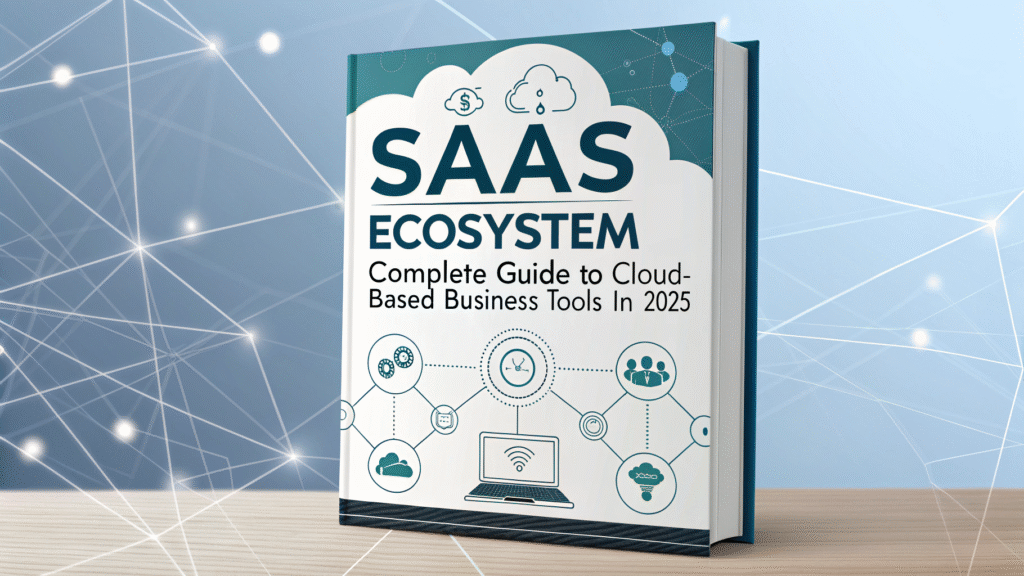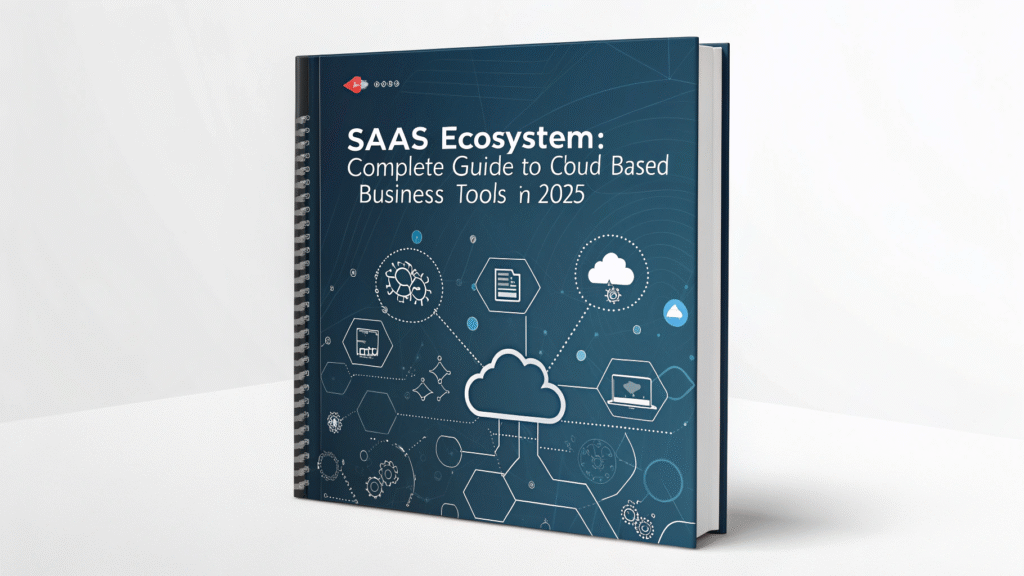
Table of Contents
- Introduction: SaaS Ecosystem
- History & Evolution
- Audience & Demographics
- Key Features & Functions
- Business & Marketing Potential
- Best Practices & Tips
- Challenges & Limitations
- Future Outlook
- Conclusion
Introduction: SaaS Ecosystem
Running an online business today means juggling countless tasks—email marketing, customer relationship management, project tracking, accounting, social media scheduling, and more. Twenty years ago, this required expensive software installations, IT departments, and dedicated servers. Today, everything lives in the cloud, accessible from anywhere with an internet connection.
Welcome to the SaaS ecosystem—the interconnected suite of cloud-based tools that businesses use to operate online efficiently. Rather than downloading software onto individual computers, you access powerful applications through your web browser, paying monthly subscriptions instead of hefty upfront costs.
This revolutionary shift democratized business technology. Solopreneurs now access the same sophisticated tools that Fortune 500 companies use, often for less than the cost of a daily coffee. However, navigating this ecosystem can feel overwhelming with thousands of options competing for your attention and budget.
Understanding how the SaaS ecosystem works transforms chaos into streamlined efficiency. When tools communicate seamlessly, data flows automatically, and repetitive tasks disappear, you finally focus on what matters—growing your business and serving customers.
Let’s explore how this ecosystem evolved, why it matters, and how you can leverage it to build a thriving online business.
History & Evolution
The Pre-Cloud Era
Before 2000, businesses purchased software in physical boxes, installing it on individual computers. Microsoft Office cost hundreds of dollars per license. Enterprise solutions like SAP required massive investments in hardware, installation, and ongoing maintenance. Small businesses couldn’t compete with corporate technology budgets.
The Birth of SaaS
Salesforce launched in 1999 with a revolutionary concept: customer relationship management (CRM) software delivered entirely through web browsers. Their slogan “No Software” challenged conventional thinking. Users paid monthly fees instead of buying licenses, and Salesforce handled all technical maintenance.
Meanwhile, other pioneers emerged. NetSuite introduced cloud-based accounting in 1998, and Concur transformed expense management. These early adopters proved that businesses would trust critical operations to cloud-based platforms.
The Explosion of Choice
The 2010s saw explosive growth. Mobile devices, improved internet speeds, and widespread cloud acceptance created perfect conditions. Furthermore, development frameworks and APIs made building SaaS applications easier and cheaper than ever before.
Suddenly, specialized solutions emerged for every business function:
- Communication (Slack, Zoom)
- Marketing (HubSpot, Mailchimp)
- Design (Canva, Figma)
- Project management (Asana, Trello)
- E-commerce (Shopify, WooCommerce)
The Integration Revolution
Companies like Zapier (2011) and Integromat/Make (2012) solved a critical problem: connecting disparate tools. These integration platforms allowed data to flow automatically between applications, creating truly interconnected ecosystems rather than isolated software islands.
Today’s Mature Ecosystem
The modern SaaS ecosystem features over 30,000 applications. Additionally, artificial intelligence integration, mobile-first design, and sophisticated automation capabilities make these tools more powerful than ever. Most importantly, they work together seamlessly, creating workflows that seemed impossible just a decade ago.
Audience & Demographics
Who Depends on SaaS Ecosystems?
Solo Entrepreneurs: Freelancers, consultants, and content creators manage entire businesses using only SaaS tools, eliminating traditional overhead costs.
Small Business Owners: Companies with 2-50 employees build complete operational infrastructures without hiring IT staff or purchasing expensive equipment.
Digital Marketers: Agencies coordinate campaigns across multiple platforms, tracking performance and client communications through integrated tool suites.
E-commerce Businesses: Online retailers manage inventory, process payments, fulfill orders, and handle customer service entirely through cloud applications.
Remote Teams: Distributed workforces collaborate effectively using communication, project management, and file-sharing SaaS solutions.
Startups: New ventures launch quickly with minimal capital investment, scaling their tech stack as they grow.
Market Size and Growth
The global SaaS market exceeded $195 billion in 2023 and continues growing at 18% annually. Moreover, businesses now spend 15-20% of their total budgets on SaaS subscriptions. The average company uses 130 different SaaS applications, demonstrating how deeply embedded these tools have become.
User Behavior Trends
Modern professionals expect:
- Mobile accessibility for on-the-go management
- Intuitive interfaces requiring minimal training
- Instant setup with no technical expertise
- Flexible pricing that scales with business needs
- Strong security and data privacy protections
Key Features & Functions
Cloud-Based Accessibility
Access your tools from anywhere with internet connectivity. Work from home, coffee shops, or while traveling without losing functionality. Data syncs automatically across devices, ensuring you always have the latest information.
Subscription Pricing Models
Pay predictable monthly or annual fees instead of large upfront costs. Most platforms offer tiered pricing:
- Free plans for basic features
- Starter plans ($10-50/month) for individuals
- Professional plans ($50-200/month) for small teams
- Enterprise plans (custom pricing) for large organizations
Automatic Updates and Maintenance
SaaS providers handle all technical maintenance, security patches, and feature updates automatically. You never worry about outdated software or compatibility issues. Simply log in and access the latest version instantly.
Scalability
Start with basic features and upgrade as your business grows. Add users, increase storage, or unlock advanced functionality without migration headaches. Similarly, downgrade during slower periods without losing your data.
Integration Capabilities
Modern SaaS applications connect through APIs (Application Programming Interfaces), allowing data to flow between systems:
- Contact information syncs between email and CRM
- E-commerce sales update accounting records
- Calendar appointments trigger reminder emails
- Form submissions create project tasks
Collaboration Tools
Multiple team members access the same data simultaneously. Real-time editing, commenting, and sharing eliminate version control nightmares. Additionally, permission settings ensure sensitive information stays secure.
Analytics and Reporting
Built-in dashboards track key performance metrics. Monitor customer behavior, campaign results, financial performance, and operational efficiency without spreadsheet gymnastics.
Business & Marketing Potential
Reduced Capital Requirements
Launch businesses with minimal upfront investment. A comprehensive tech stack that once cost $50,000+ now costs $100-300 monthly. This democratization allows anyone with good ideas to compete effectively.
Operational Efficiency
Automation eliminates repetitive tasks:
- Email sequences nurture leads automatically
- Invoices generate and send themselves
- Social media posts schedule weeks in advance
- Customer data updates across all platforms
Professional Presentation
Small businesses project enterprise-level professionalism. Custom domains, branded communications, and sophisticated customer experiences make you indistinguishable from larger competitors.
Data-Driven Decision Making
Comprehensive analytics reveal what works and what doesn’t. Track customer acquisition costs, lifetime value, conversion rates, and ROI for every marketing channel. Consequently, you allocate resources more effectively.
Global Reach
Cloud-based tools enable international business operations without physical presence. Accept payments in multiple currencies, communicate across time zones, and serve customers worldwide seamlessly.
Faster Time to Market
Launch products and services quickly using pre-built infrastructure. E-commerce stores go live in hours rather than months. Marketing campaigns deploy immediately without technical bottlenecks.
Best Practices & Tips
Start with Core Essentials
Don’t overwhelm yourself with too many tools initially. Begin with:
- Communication platform (Slack, Microsoft Teams)
- Email marketing (Mailchimp, ConvertKit)
- CRM (HubSpot, Pipedrive)
- Project management (Asana, Monday.com)
- Accounting (QuickBooks, Xero)
Prioritize Integration Compatibility
Choose tools that connect easily. Check integration marketplaces before committing. Platforms with Zapier connectivity offer maximum flexibility, connecting with thousands of other applications effortlessly.
Take Advantage of Free Trials
Most SaaS providers offer 14-30 day free trials. Test thoroughly during this period:
- Import sample data
- Run common workflows
- Evaluate customer support responsiveness
- Assess mobile app functionality
- Check reporting capabilities
Audit Your Stack Regularly
Review subscriptions quarterly:
- Cancel unused tools
- Consolidate overlapping functionality
- Negotiate annual pricing for savings
- Update payment methods to avoid interruptions
Invest in Training
Most SaaS platforms offer free training resources—webinars, documentation, video tutorials, and certification programs. Spending time learning advanced features dramatically increases ROI and prevents underutilization.
Implement Proper Security Practices
Protect your ecosystem:
- Use unique, strong passwords for each platform
- Enable two-factor authentication everywhere
- Review user permissions regularly
- Understand data backup policies
- Use password managers (LastPass, 1Password)
Document Your Workflows
Create process documentation showing:
- Which tools handle specific tasks
- How data flows between systems
- Who owns different responsibilities
- Troubleshooting common issues
Monitor Performance Metrics
Track key indicators for each tool:
- Email open and click rates
- CRM pipeline conversion rates
- Project completion timelines
- Support ticket resolution times
- Website uptime percentages
Challenges & Limitations
Subscription Fatigue
Monthly costs accumulate quickly. A “modest” stack can easily reach $500-1,000 monthly. Additionally, you might pay for features you never use because they’re bundled with essential functions.
Integration Complexity
Despite continuous improvements, connecting tools within the SaaS ecosystem sometimes requires technical knowledge. Often, APIs break, data formats conflict, and synchronization errors occur. Furthermore, maintaining these integrations adds an ongoing administrative burden, especially as the number of connected platforms grows.
Data Privacy Concerns
Trusting multiple vendors with sensitive business information creates risk. Data breaches, unauthorized access, and compliance violations pose serious threats. Moreover, understanding where your data lives and who can access it becomes increasingly complicated.
Vendor Lock-In
Switching platforms after accumulating years of data can be extremely difficult. Export formats may not match import requirements. Historical data might not transfer completely. Consequently, businesses feel trapped with suboptimal solutions.
Internet Dependency
SaaS ecosystems require reliable internet connectivity. Outages halt productivity completely. While some applications offer offline modes, functionality becomes severely limited without cloud access.
Learning Curve Multiplication
Each new tool requires learning. Training multiple team members across numerous platforms consumes significant time. Additionally, frequent updates change interfaces and workflows, requiring continuous adaptation.
Limited Customization
Unlike custom-built software, SaaS applications offer finite configuration options. Your workflows must adapt to the software rather than vice versa, which sometimes forces uncomfortable compromises.
Future Outlook
AI Integration Acceleration
Artificial intelligence will transform SaaS capabilities:
- Predictive analytics forecasting business trends
- Automated content generation for marketing
- Intelligent routing of customer inquiries
- Smart scheduling optimizing team calendars
- Anomaly detection preventing fraud
Vertical-Specific Solutions
Expect more industry-focused platforms combining multiple functions. Rather than cobbling together general tools, businesses will adopt comprehensive solutions designed specifically for their sector—healthcare, legal services, construction, restaurants, etc.
No-Code/Low-Code Expansion
Building custom workflows and mini-applications will become accessible to non-technical users. Visual builders and templates empower business owners to create exactly what they need without hiring developers.
Blockchain Integration
Decentralized technologies may address data portability and vendor lock-in challenges. Smart contracts could automate complex business agreements, while distributed storage increases security and ownership.
Sustainability Focus
Cloud providers will emphasize environmental responsibility. Carbon-neutral data centers, energy-efficient operations, and transparent sustainability reporting will influence purchasing decisions.

Conclusion
The SaaS ecosystem represents the most significant democratization of business technology in history. Tools that once cost hundreds of thousands of dollars now cost mere hundreds, leveling the playing field between entrepreneurs and corporations. Moreover, continuous innovation means tomorrow’s capabilities will exceed today’s imagination.
Success doesn’t require mastering every available tool—just selecting the right combination for your specific needs. Start small, integrate thoughtfully, and scale strategically. Pay attention to how tools work together rather than accumulating disconnected applications.
The barrier to entry for online business has never been lower. The technology exists to support virtually any business model you can envision. The only question is whether you’ll take advantage of these incredible resources.
Ready to build your ideal SaaS ecosystem? Start by identifying your biggest operational bottleneck—the repetitive task consuming the most time. Find one tool that solves that problem, implement it fully, then gradually add complementary solutions. Before long, you’ll have created an efficient, automated business infrastructure that works for you 24/7.
The future belongs to businesses that leverage technology effectively. Your perfect ecosystem is waiting—start building it today.